'˜Lest We Forget' theme at commemorations


The Northern Ireland remembrances will be replicated in cities, town and villages in other parts of the United Kingdom.
Many of the church services will be preceded by wreath-laying ceremonies at cenotaphs and war memorials, organised by the Royal British Legion, a charity dedicated to perpetuating the memory of those who gallantly served in the First World War and veterans of all subsequent wars involving British and Commonwealth troops.
Advertisement
Hide AdAdvertisement
Hide AdArmistice Day (November 11), coming either ahead or after the Remembrance Sunday events, has been increasingly recognised, with the main ceremony at the Cenotaph in London, where the Queen and Government ministers lead the tributes.
The anniversary remembers all the people who died in not just World War One (1914-19). This includes World War Two (1939-45), Northern Ireland ‘Troubles’, Falklands War (1980s), the Gulf War (1990-91), and more recent conflicts in Afghanistan and Iraq.
The first two-minute silence in Britain was held on November 11, 1919, when King George V asked the public to observe a silence at 11am. The King made the request so “the thoughts of everyone may be concentrated on reverent remembrance of the glorious dead”.
In the United States, the function of Veterans’ Day is subtly different from that of November 11 observances in Britain.
Advertisement
Hide AdAdvertisement
Hide AdInstead of specifically honouring war dead, Veterans Day recognises all American veterans living and dead. The official national remembrance of those killed in action is Memorial Day (Last Monday in May), originally called ‘Decoration Day’, from the practice of holding parades featuring veterans wearing their military decorations, which began in the years immediately after the American Civil War in the 1860s.
The American public, in the everyday life of the nation, go to great lengths to recognise and support their servicemen and women.
Armistice Day remains the name of a holiday in France and Belgium, and it is also a statutory holiday in Serbia, a nation that played a key role in defeating Nazi Germany in the 1940s. In Italy, the end of World War One is marked on November 4.
* Tomorrow morning, Church of Ireland Primate Archbishop Richard Clarke and Roman Catholic Primate Archbishop Eamon Martin will jointly lay a wreath at the War Memorial in Armagh city.
Advertisement
Hide AdAdvertisement
Hide AdAfter the ceremony, both archbishops will attend the service at St Patrick’s Church of Ireland cathedral.
The act of joint jointly laying a wreath in remembrance follows on from both Archbishops leading a peace pilgrimage to First World War sites of battle of 1916 in France and Belgium last June. They were accompanied by a young adult group drawn from both Church of Ireland and Roman Catholic traditions across Ireland. The pilgrimage included laying of a wreath symbolising peace at Menin Gate, Ypres.